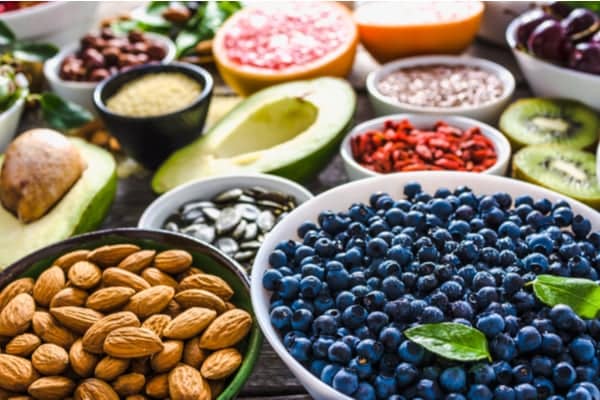Refined carbohydrates, complex carbohydrates, added sugars, natural sugars, non-nutritive sweeteners…
Even as a nutrition specialist or certified nutrition coach, it can be difficult to keep all of these terms straight, and it can be even harder to answer your clients’ questions on the fly about added sugars.
To help clear up the confusion, we’ve summarized the most important things you need to know about added sugars in this article, including what they are, how they are different from other sugars and carbs, how to know how much is found in foods, and the current recommendations around added sugar consumption.
The Science of Sugars
What exactly defines a sugar? The answer is in the chemical composition of the nutrient.
In general terms, sugars are a type of carbohydrate, which are composed of carbon, hydrogen, and oxygen molecules. Most sugars are broken down by the digestive system into glucose, a component that is readily used by cells as energy. In fact, it is the preferred source of energy for most of our cells, including red blood cells, the brain, and nervous system cells, and the muscles.
Sugars are sweet-tasting, and they are naturally occurring in plant foods, like fruits and vegetables; dairy; and human breast milk.
There are several types of sugars that differ in their chemical composition and, thus, their metabolism in the human body.
Sugars can be monosaccharide or disaccharide carbohydrates. Both types of sugars are naturally occurring. Monosaccharides are single units, and they can be absorbed directly into the bloodstream without the need to break down. These include
- Glucose (dextrose)
- Fructose
- Galactose
- Mannose

Get Your Free Guide to Becoming a Holistic Nutritionist
Learn about the important role of holistic nutritionists, what it takes to be successful as one, and how to build a lucrative, impactful career in nutrition.
Disaccharides are made up of two monosaccharides. The body breaks these down into monosaccharides before absorbing and using them in the cell. The most common disaccharides are:
- Sucrose (the most common sugar, also known as table sugar) = glucose + fructose. This is found in sugar cane, beets, fruits, and vegetables.
- Maltose = glucose + glucose. This is found in molasses.
- Lactose = glucose + galactose. This is found in milk or dairy.
- Trehalose = glucose + glucose, linked in a different position than maltose. This is found in mushrooms.
Sugars vs. Sugar
To sum up the information above, when we talk about sugars (with an “S” at the end), we need to remember there are multiple kinds.
Sugars are naturally occurring in plant foods, honey, and dairy, and they are found together with other nutrients. Sugars can also be extracted through commercial processes so that they are separated from other nutrients. This is the case with syrups like corn syrup and maple syrup and granulated sugar.
Sugar (without the “S” at the end), on the other hand, is the common term for sucrose, or granulated table sugar.
So, when you see total sugars on the nutrition facts label, it refers to the amount of sugar in the packaged food, both added and naturally occurring.
FDA regulations now require food labels for foods produced and sold in the US to include a listing of added sugars in grams under total sugars. Added sugars may be sucrose, but they could also be any other chemical form of sugar.
Take a look at this article for more information on understanding the nutrition facts label.
Glossary of Sugar Terms
- Carbohydrates: One of three main nutrients used as energy sources by the body. They include sugars, starches, and fiber.
- Sugars: An umbrella term that includes monosaccharides (glucose, fructose, galactose, and mannose) and disaccharides (sucrose, maltose, lactose, and trelahose).
- Sugar: The colloquial term for sucrose, or table sugar. Sucrose is one kind of sugar.
- Added sugars: The FDA defines added sugars as “sugars that are added during the processing of foods (such as sucrose or dextrose), foods packaged as sweeteners (such as table sugar), sugars from syrups and honey, and sugars from concentrated fruit or vegetable juices.”
- Naturally-occurring sugars: Those that are naturally found in milk, fruits, and vegetables.
- Fiber: A type of carbohydrate that is not digestible by the human gut. In this sense, fiber doesn’t contribute energy to the diet; however, fiber does promote gut and heart health by acting as food for healthy gut microbiome and regulating digestion.
- Starch: Together with fiber and sugar, starch is the third type of carbohydrate that forms part of the human diet. It is a polysaccharide, meaning that it is composed of three or more monosaccharides. Grains, potatoes, and corn are all common sources of starch in the human diet.
Added Sugars: 7 Things You Need to Know
Overconsumption of added sugar may be linked to chronic disease, but overall diet is a more important factor.
The FDA lists nutrients on the nutrition facts label that are of importance to public health. In the seventeen years that it took to include the listing on the label from when the petition was made, important evidence surfaced on the role of added sugars in health.
A systematic review of evidence found that while the consumption of added sugars is linked to an increased risk of developing chronic diseases such as diabetes and cardiovascular disease, singling out added sugars as culprits of chronic disease is inconsistent.
For example, the research around how overall phytonutrient and fiber intake promote health is much more consistent than the research that connects added sugar intake to health problems. In this sense, it is safe to say that it is more important to get enough fruits, vegetables, and complex carbohydrate sources in the diet than it is to eliminate nutrients.
Thus, while paying attention to added sugars and moderating their consumption, overall dietary quality, including having an intake of nutrient-rich food sources that meet macronutrient and micronutrient needs, is more important than singling out added sugar.
Listing Added Sugars in the nutrition facts labels may help the population consume healthier dietary patterns.
The FDA recognizes that there isn’t a classic cause-effect linkage between the consumption of added sugars and a specific health outcome. It also recognizes, however, that limiting the consumption of added sugars is important for consuming an overall healthier diet and further research on the link between added sugar consumption and health risks is needed.
The FDA’s Daily Value for added sugars is 50 grams per day based on a 2,000 calorie daily diet.
Fifty grams per day of added sugars is equivalent to 200 calories.
On nutrition facts labels, added sugars are listed below Total Sugars as “Includes Xg added sugars” and then the percent daily value. Gram amount can help you get an idea of how much of the total sugars are added, and the percent daily value may help to inform you about the proportion of added sugars a serving of that food contributes to the recommended limit for a day.
Keep in mind that these recommendations are based on a 2,000 calorie diet, so the Daily Value may be more or less depending on your energy needs. Athletes and people who regularly engage in fitness, for example, have greater calorie, and thus, carbohydrate needs, often ranging between 3,000 and 3,500 calories and beyond. Consuming sugars may be a good way to achieve energy needs.
Where does the 2,000 calorie label standard come from?
It isn’t based on scientific estimations of our energy needs, as you might think. It is based on self-reported food consumption surveys in the US in the early 90s. Average calorie consumption was calculated based on the surveys, where women reported an intake of 1,600 and 2,200 and men reported intakes between 2,000 and 3,000 calories. As you can imagine, there was a lot of rounding and, likely, underestimation of actual food consumption.
50 g of added sugars is equal to 4 tablespoons or 12 teaspoons of sucrose (table sugar).
The sugar and caloric sweeteners you add to your coffee, tea, and baked goods are also added sugars. Some of the most common sugar-based sweeteners include:
- Table sugar (sucrose), white or brown
- Molasses
- Honey
- Syrup
- Agave nectar
- Corn syrup
You don’t need to “cut out” added sugars.
Most healthy people do not need to eliminate added sugars from their diet. The Dietary Guidelines for Americans state that “a limited amount of added sugars can be included as part of an overall healthy eating pattern.” It is vital to keep a critical eye, though, as the dietary guidelines for Americans are influenced by people in the agribusiness space, including the sugar industry.
However, it is important to learn about your client’s individual nutritional needs; since, in most states, health and nutrition coaches are not permitted to make individualized recommendations or diagnoses, your client might want to work with a registered dietitian or licensed nutritionist to help them determine those needs. Then, they can work with a certified health coach or nutrition coach to build a plan using behavior change science.
Overall, people can check in with themselves and how they feel when they are hungry and after eating certain foods. An intuitive eating approach can help people build a healthy relationship with food while also enjoying their meals.
You can look at the ingredient labels to find the source of sugars.
In the nutrition facts label, the source of added sugars is not listed. If the type of added sugars is important to you, you can find that out by reading the ingredient label.
Some common added sugars listed in the ingredient label include:
- Sugar
- Cane sugar/cane juice crystals
- Beet/date/coconut/panela/maple/brown sugar
- Sucrose
- High fructose corn syrup (HFCS 55 or HFCS 42)
- Agave nectar
- Buttered syrup
- Caramel
- Carob syrup
- Confectioner’s sugar
- Maple syrup
- Molasses
- Honey
- Fruit juice concentrate
- Sucanat
- Raw sugar
- Barley malt
- Brown rice syrup
- Corn syrup/corn syrup solids
- Lactose
- Glucose
- Maltose
- Maltodextrin
- Ethyl maltol
- Diastatic malt
- Dextrose
- Dextrin
People with metabolic disorders should seek personalized advice on added sugar consumption.
An exception to the general guidelines on added sugar consumption may be when a person has a metabolic condition, like type 2 diabetes, where the body has difficulties metabolizing sugar. In these cases, it is important that the individual seek support from a dietician or licensed nutritionist for a diagnosis and personalized guidance. A nutrition coach can help support people with metabolic conditions apply the recommendations to their lifestyle.
A Note About the High Fructose Corn Syrup Debate
Of all the added sugars, high fructose corn syrup (HFCS) might be the most controversial. High fructose corn syrup is an industrially produced sweetener that comes from corn starch. It contains fructose and glucose, and the two most common varieties contain either 55% fructose or 42% fructose. The US food industry often prefers using HFCS over other sweeteners because it is readily available and corn production is subsidized by the government; the US has a vast corn production, but most cane sugar is imported. In short, the use of HFCS is a cheaper sweetener to use than alternatives.
HFCS doesn’t have a wildly different composition than that of sucrose (table sugar), which contains 50% fructose and 50% glucose.
The general public has the perception that high fructose corn syrup is significantly worse for our health than other added sugars.
A study examined the impact of honey, sucrose, and HFCS on measures of glycemia, lipid metabolism, and inflammation. The study found that all three increase triglyceride concentrations in both glucose tolerant individuals and those with impaired glucose tolerance. All three sweeteners also resulted in elevated glycemic and inflammatory responses in people with impaired glucose tolerance but not in people with glucose tolerance. In other words, honey, table sugar, and HFCS all have a similar impact on measures of heart health and inflammation.
Another study compared the impact of high fructose corn syrup or table sugar on measures of liver health, and it appeared that overall excessive energy intake had a much greater influence on liver health than the source of added sugar.
Additionally, only non-nutritive sweeteners appear to have an impact on gut microbiota composition.
In this sense, the issue with HFCS isn’t the form of the sugar, so much as it is about the frequency with which it is used in, and how widely it is embraced by, the food industry. Because it is relatively cheap and improves the taste of processed foods, both savory and sweet, it is found to some degree in most processed foods.
The problem isn’t the source or form of the sweetener so much as how it adds calories without other nutrients and contributes to the appetizing qualities of food. As a result, it influences people’s impulse to eat past a point of satisfaction and beyond true energy needs.
Main Takeaways
As a health coach or an individual concerned about their health, it is useful to be informed about the role of different nutrients in supporting overall health. While it can be tempting to villainize or glorify specific nutrients, this habit can often cause anxiety and restrictive eating habits that are not sustainable.
Added sugars are part of the food environment in most countries in the world, especially in industrialized countries. We are learning more every day about the role added sugars play in our body’s health. We’ve learned that we should moderate our consumption of added sugars and that it is possible to consume added sugars and have an overall balanced diet, with the exception of some metabolic diseases.
Health and nutrition coaches can have an important role in helping people understand nutrition guidelines and apply them to their lifestyles for realistic and lasting habit changes that can promote overall health and wellness.

Get Your Free Guide to Becoming a Holistic Nutritionist
Learn about the important role of holistic nutritionists, what it takes to be successful as one, and how to build a lucrative, impactful career in nutrition.
References
- https://www.ift.org/career-development/learn-about-food-science/food-facts/food-facts-food-ingredients-and-additives/sugars-a-scientific-overview
- https://www.sciencedirect.com/science/article/abs/pii/S0195666317300430
- https://www.medicinenet.com/carbohydrates/definition.htm
- https://www.fda.gov/food/new-nutrition-facts-label/added-sugars-new-nutrition-facts-label
- https://www.researchgate.net/publication/317037665_Difference_Between_Sugar_and_Starch#:~:text=The%20combination%20of%20two%20monosaccharides,whereas%20starch%20is%20a%20polysaccharide.
- https://www.sciencedirect.com/science/article/abs/pii/S0195666317300430
- https://www.mdpi.com/2072-6643/8/11/697
- https://www.federalregister.gov/documents/2016/05/27/2016-11867/food-labeling-revision-of-the-nutrition-and-supplement-facts-labels#page-33799



